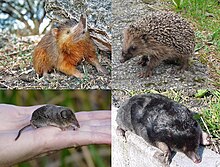真盲缺目
哺乳动物的一目
真盲缺目(学名:Eulipotyphla)又名劳亚食虫目,是哺乳动物的一目。原本,本目的物种被归于现已不再使用的食虫目中,但因种系发生的研究确定食虫目是多系群,而被重新分类成“盲缺目”(Lipotyphla)指没有盲肠的动物;随后,又移除了马岛猬及金毛鼹等非洲猬目动物,成为现在的“真盲缺目”(或称“劳亚食虫目”)。
| 真盲缺目 化石时期:
| |
|---|---|

| |
| 由左上角顺时针分别是海地沟齿鼩、剌猬(可能为西欧刺猬或北方白胸刺猬)、欧洲鼹鼠及饰纹鼩鼱 | |
| 科学分类 | |
| 界: | 动物界 Animalia |
| 门: | 脊索动物门 Chordata |
| 纲: | 哺乳纲 Mammalia |
| 高目: | 北方真兽高目 Boreoeutheria |
| 总目: | 劳亚兽总目 Laurasiatheria |
| 目: | 真盲缺目 Eulipotyphla Waddell et al., 1999 |
| 科 | |
分类
编辑- 真盲缺目 Eulipotyphla
依据Roca et al.与Brace et al.的研究,既存本目动物间的关系如下[2][7]:
| 真盲缺目 |
| ||||||||||||||||||||||||
上面种系发生树的上下两个分支被分子钟推定约于7,200万至7,400万年前分开演化[7],岛鼯科与沟齿鼩科约于5,700万年前分开演化[7],鼹科与最下面的两科约于6,900万年前分开演化,鼩鼱科与猬科则约于6,400万年前分开演化[8]。
参考资料
编辑- ^ Douady, C. J.; Chatelier, P. I.; Madsen, O.; de Jong, W. W.; Catzeflis, F.; Springer, M. S.; Stanhope, M. J. Molecular phylogenetic evidence confirming the Eulipotyphla concept and in support of hedgehogs as the sister group to shrews. Molecular Phylogenetics and Evolution. October 2002, 25 (1): 200–209. PMID 12383761. doi:10.1016/S1055-7903(02)00232-4.
- ^ 2.0 2.1 Roca, A. L.; Bar-Gal, G. K.; Eizirik, E.; Helgen, K. M.; Maria, R.; Springer, M. S.; O'Brien, S. J.; Murphy, W. J. Mesozoic origin for West Indian insectivores. Nature. 2004-06-10, 429 (6992): 649–651. Bibcode:2004Natur.429..649R. PMID 15190349. S2CID 915633. doi:10.1038/nature02597.
- ^ Bininda-Emonds, O. R. P.; Cardillo, M.; Jones, K. E.; MacPhee, R. D. E.; Beck, R. M. D.; Grenyer, R.; Price, S. A.; Vos, R. A.; Gittleman, J. L.; Purvis, A. The delayed rise of present-day mammals. Nature. 2007-03-29, 446 (7135): 507–512. Bibcode:2007Natur.446..507B. PMID 17392779. S2CID 4314965. doi:10.1038/nature05634.
- ^ Kim, N.H.; Lim, S.J.; Chae, H.M.; Park, Y.C. Complete mitochondrial genome of the Amur hedgehog Erinaceus amurensis (Erinaceidae) and higher phylogeny of the family Erinaceidae. Genetics and Molecular Research. 2017, 16 (1). PMID 28198504. doi:10.4238/gmr16019300 .
- ^ Dubey, S.; Salamin, N.; Ohdachi, S.D.; Barrière, P.; Vogel, P. Molecular phylogenetics of shrews (Mammalia: Soricidae) reveal timing of transcontinental colonizations. Molecular Phylogenetics and Evolution. 2007, 44 (1): 126–137. PMID 17267241. doi:10.1016/j.ympev.2006.12.002.
- ^ He, K.; Shinohara, A.; Helgen, K.M.; Springer, M.S.; Jiang, X.-L.; Campbell, K.L. Talpid Mole Phylogeny Unites Shrew Moles and Illuminates Overlooked Cryptic Species Diversity. Molecular Biology and Evolution. 2017, 34 (1): 78–87. PMID 27795230. doi:10.1093/molbev/msw221 .
- ^ 7.0 7.1 7.2 Brace, S.; Thomas, J. A.; Dalén, L.; Burger, J.; MacPhee, R. D. E.; Barnes, I.; Turvey, S. T. Evolutionary History of the Nesophontidae, the Last Unplaced Recent Mammal Family. Molecular Biology and Evolution. 2016, 33 (12): 3095–3103. PMID 27624716. doi:10.1093/molbev/msw186 .
- ^ Springer, M. S.; Murphy, W. J.; Roca, A. L. Appropriate fossil calibrations and tree constraints uphold the Mesozoic divergence of solenodons from other extant mammals. Molecular Phylogenetics and Evolution. 2018, 121: 158–165. PMID 29331683. doi:10.1016/j.ympev.2018.01.007.